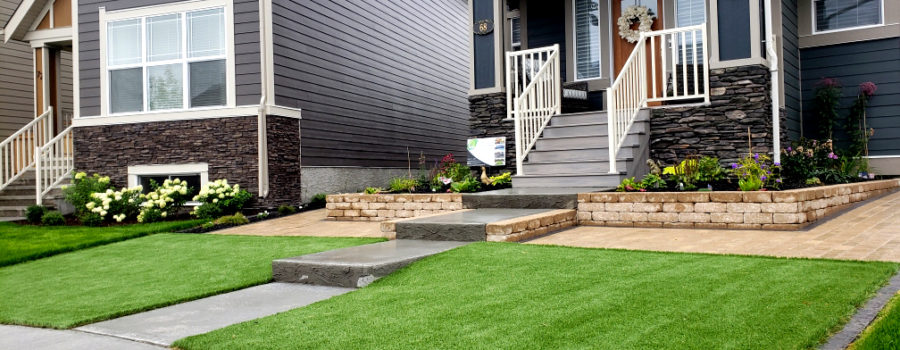Regular lawn maintenance is important – healthy grass resists disease and insects, and recovers faster than neglected turfgrass. We don’t always get the amount of rain that we would like in Calgary, so with a bit of watering and some proper management, you can keep your lawn healthy and looking great!
Water
Your lawn needs an inch (2.5 cm) of water per week (including rain) when it is actively growing in the summer. Avoid frequent light watering, which results in shallow rooting, and overwatering – saturated soil prevents air from reaching the root zone where it’s required. Water evenly and slowly enough so that the water penetrates the soil without running off.
For newly installed sod, we’ll cover that in an upcoming article.
Mow
Proper mowing keeps turfgrass healthy and beautiful. Bluegrass should be mowed at a height of between 2-3″ (5-8 cm). Never remove more than 1/3 of the leaf height at once. Don’t let the grass grow so tall that it falls over. The taller the grass, the less dense the lawn and the higher the chance of weed infestation. Always keep the mower blades sharp.
Fertilize
How much fertilizer your lawn needs depends on soil fertility and how much growth you want. We recommend using a starter fertilizer with newly installed grass. Continue to fertilize using a 4-Step Program, which can be purchased at any local garden centre. Always water in the fertilizer to prevent burning. Never apply fertilizer to wet grass leaves, especially during extreme heat.
Maintain
Compacted soil prevents water, air and nutrients from reaching turfgrass roots. Heavy soils such as clay and wet soils are prone to compaction, especially in high-traffic areas. Annual lawn aeration and topdressing will help to refresh and rejuvenate your lawn for the growing season. A healthy, well-maintained lawn should have minimal thatch (accumulation of old leaves, clippings, stems, roots, and other organic material that has failed to decay). Thatch can prevent water and fertilizer from reaching the root zone as well as harbour plant diseases and pests. Raking thoroughly is usually enough to remove thatch, however, in severe cases use either a vertical mower or contact a local landscape professional.
Monitor
It is important to keep an eye on your grass throughout the summer. By monitoring your grass regularly you 1) reduce the risk of undesirable conditions, such as pests or weeds taking over your lawn, 2) you will spot problems early, making them much easier to deal with. Below you can find guidelines for a number of lawn-related problems you may encounter.
We trust that with these tips, you can keep your lawn looking lush and healthy for years to come. If you are in need of a new lawn or other landscaping projects, we’d love to help. Contact us, or give us a call (403) 617-3225


